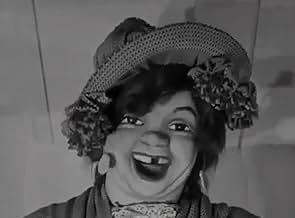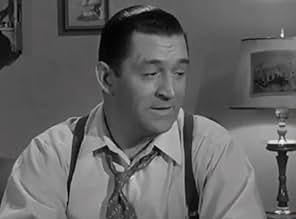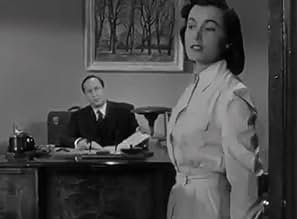VALUTAZIONE IMDb
6,2/10
911
LA TUA VALUTAZIONE
Aggiungi una trama nella tua linguaMany interested parties are after the loot from a factory payroll heist but the mobster who hid it has amnesia after undergoing experimental brain surgery in the prison hospital.Many interested parties are after the loot from a factory payroll heist but the mobster who hid it has amnesia after undergoing experimental brain surgery in the prison hospital.Many interested parties are after the loot from a factory payroll heist but the mobster who hid it has amnesia after undergoing experimental brain surgery in the prison hospital.
- Regia
- Sceneggiatura
- Star
Chris Alcaide
- Pursuing Detective
- (non citato nei titoli originali)
Fred Aldrich
- Cop
- (non citato nei titoli originali)
Leonard Bremen
- Guard at Clinic
- (non citato nei titoli originali)
Paul Bryar
- Freddie - Bartender
- (non citato nei titoli originali)
Sayre Dearing
- Patient in Wheelchair at Clinic
- (non citato nei titoli originali)
Frank Fenton
- Detective Driver
- (non citato nei titoli originali)
John Harmon
- Herman
- (non citato nei titoli originali)
Mary Alan Hokanson
- Nurse
- (non citato nei titoli originali)
Shepard Menken
- Interne
- (non citato nei titoli originali)
Howard Negley
- Detective
- (non citato nei titoli originali)
Frank O'Connor
- Gate Guard
- (non citato nei titoli originali)
Recensioni in evidenza
Edmond O'Brien stars in "Man in the Dark," a 1953 film also starring Audrey Totter. O'Brien plays Steve Rawley, a prisoner who undergoes experimental surgery that's supposed to erase the criminal elements of his brain. It also wipes his memory of past events.
Unfortunately Steve and some other thugs committed a big robbery and Steve hid the money. Now that he has no memory, he doesn't know where he put it. His old gang kidnaps him and tries to find out his hiding place. His old girlfriend Peg (Totter) is around, and she wants him to forget the whole thing and go away with her.
Steve starts remembering things in the form of bizarre dreams. He and Peg attempt to follow the clues in the dreams to track down the money.
Edmond O'Brien made a lot of these B films for Columbia. This one is no better or worse than many of them. The last part of the film takes place in an amusement park, and it's very good.
Originally this film was in 3-D, and like some other films, it was filmed in the seen-better-days area of Ocean Park near Venice, CA. I always like seeing the old LA, and this film has lots of shots of it.
I had one major problem with this film, and it's a major plot hole. If you had stolen a lot of money and hidden it, why would you agree to a surgery that is going to clean out your memory so that you don't remember where you hid it?
I don't know the answer.
Unfortunately Steve and some other thugs committed a big robbery and Steve hid the money. Now that he has no memory, he doesn't know where he put it. His old gang kidnaps him and tries to find out his hiding place. His old girlfriend Peg (Totter) is around, and she wants him to forget the whole thing and go away with her.
Steve starts remembering things in the form of bizarre dreams. He and Peg attempt to follow the clues in the dreams to track down the money.
Edmond O'Brien made a lot of these B films for Columbia. This one is no better or worse than many of them. The last part of the film takes place in an amusement park, and it's very good.
Originally this film was in 3-D, and like some other films, it was filmed in the seen-better-days area of Ocean Park near Venice, CA. I always like seeing the old LA, and this film has lots of shots of it.
I had one major problem with this film, and it's a major plot hole. If you had stolen a lot of money and hidden it, why would you agree to a surgery that is going to clean out your memory so that you don't remember where you hid it?
I don't know the answer.
Edmond O'Brien has a severe case of retrograde amnesia, but he didn't contract it in the Pacific. He's a robber who got away with $130,000 in a Christmas Eve heist, was convicted and served his time. But he'll get a second chance if he submits to an operation to excise the criminal portion of his brain. Understandably, he's conflicted, and when they move it up from the scheduled day he balks: `I was born on a Monday. I may as well go on one like dirty laundry.' But the operation proves a stunning success, so delicate that it erases all memories of his past life but leaves him with a perfect command of American slang.
But the placid life he leads at the sanitarium pruning hedges and daubing canvases comes to an abrupt halt when he's kidnaped by his old gang, now led by Ted De Corsia. They want the money, which was never recovered; so does an implacable Javert of an insurance investigator. Even his old girlfriend (Audrey Totter) sees him only as a ticket to the high life, until she falls for the new, improved O'Brien and renounces her grasping ways. (The often ill-used Totter shines here, especially on a martini bender when she asks the bartender, `Oh, Fred, what do you do when you hate yourself?')
Odd clues begin to surface from O'Brien's troubled nightmares, however, leading him and Totter (with the rest of the cast plus the police in pursuit) to claim a parcel left at an amusement park. And this is the big set-piece of the movie, originally released in 3-D. Cars come whooshing around the curves and down the dips of a roller coaster while pitched battles are being fought on the tracks. Watching these 3-D movies now is like drinking soda that's gone flat: All the ingredients are there but the sparkle's gone. But in their endearingly gimmicky way, they evoke their era, as do the flats equipped with party lines and furnished with lampshades bearing reproductions of paintings. Man in the Dark's too short, and needs an extra layer of complexity. But there's still a bit of fizz left in it.
But the placid life he leads at the sanitarium pruning hedges and daubing canvases comes to an abrupt halt when he's kidnaped by his old gang, now led by Ted De Corsia. They want the money, which was never recovered; so does an implacable Javert of an insurance investigator. Even his old girlfriend (Audrey Totter) sees him only as a ticket to the high life, until she falls for the new, improved O'Brien and renounces her grasping ways. (The often ill-used Totter shines here, especially on a martini bender when she asks the bartender, `Oh, Fred, what do you do when you hate yourself?')
Odd clues begin to surface from O'Brien's troubled nightmares, however, leading him and Totter (with the rest of the cast plus the police in pursuit) to claim a parcel left at an amusement park. And this is the big set-piece of the movie, originally released in 3-D. Cars come whooshing around the curves and down the dips of a roller coaster while pitched battles are being fought on the tracks. Watching these 3-D movies now is like drinking soda that's gone flat: All the ingredients are there but the sparkle's gone. But in their endearingly gimmicky way, they evoke their era, as do the flats equipped with party lines and furnished with lampshades bearing reproductions of paintings. Man in the Dark's too short, and needs an extra layer of complexity. But there's still a bit of fizz left in it.
After reading some negative reviews of this film, I expected it to be a pretty stale B-movie about gangsters and stolen dough. However, I found this to be a pretty entertaining B-movie with some humorous 3-D effects, and some wonderful footage of an amusement park circa 1953.
The script for this film, is indeed pretty routine with the typical gangster stereotypes seen in most films of the period. Edmund O'Brien gives a very good performance, however. There are also a few other familiar character actors in the film, which make for interesting viewing.
The 3-D gimmicks utilized throughout (scalpels, cigars, guns, a flower pot, roller coaster) are fun to spot, and good for a laugh. The greatest asset this film has though, is it's use of location filming. There is an interesting chase across some rooftops which works very well, but best of all are the amusement park scenes, including a roller coaster ride, and some really nice close-ups of the Fun House Laughing Sal figure. If for no other reason, see the film for her presence.
The script for this film, is indeed pretty routine with the typical gangster stereotypes seen in most films of the period. Edmund O'Brien gives a very good performance, however. There are also a few other familiar character actors in the film, which make for interesting viewing.
The 3-D gimmicks utilized throughout (scalpels, cigars, guns, a flower pot, roller coaster) are fun to spot, and good for a laugh. The greatest asset this film has though, is it's use of location filming. There is an interesting chase across some rooftops which works very well, but best of all are the amusement park scenes, including a roller coaster ride, and some really nice close-ups of the Fun House Laughing Sal figure. If for no other reason, see the film for her presence.
Here's an example of a routine thriller that could have been so much better if the script hadn't been so banal. Unfortunately, nothing really riveting happens until the last twenty minutes when the amnesiac victim enters an amusement park with some startling results.
It's the final chase scene that make the film come to life, but by that time (and even though the running time is brief), many a viewer will be turned off by the pedestrian script and the average performances.
Even old pros like Edmond O'Brien and Audrey Totter look as though they know the script is the problem. Totter, minus her usually scrappy dialog has a colorless role. She plays it straight but makes almost no impression as the woman who wants her boyfriend to amend his old ways after he finds the missing loot that the villains are chasing him for.
It was originally intended to be shown in 3D, and this is obvious from some of the gimmicky B&W photography for the carnival scene. Still, the low-budget aspect of the whole thing is apparent from the start and the final impression is of a quickie B-film unworthy of O'Brien and Totter.
Ted De Corsia has his usual tough guy role as the punk who likes to slam O'Brien around but even he is handicapped by the hackneyed tough guy dialog. Lew Landers directs the story without any distinction until the final scenes at the amusement park.
It's the final chase scene that make the film come to life, but by that time (and even though the running time is brief), many a viewer will be turned off by the pedestrian script and the average performances.
Even old pros like Edmond O'Brien and Audrey Totter look as though they know the script is the problem. Totter, minus her usually scrappy dialog has a colorless role. She plays it straight but makes almost no impression as the woman who wants her boyfriend to amend his old ways after he finds the missing loot that the villains are chasing him for.
It was originally intended to be shown in 3D, and this is obvious from some of the gimmicky B&W photography for the carnival scene. Still, the low-budget aspect of the whole thing is apparent from the start and the final impression is of a quickie B-film unworthy of O'Brien and Totter.
Ted De Corsia has his usual tough guy role as the punk who likes to slam O'Brien around but even he is handicapped by the hackneyed tough guy dialog. Lew Landers directs the story without any distinction until the final scenes at the amusement park.
I watched most of Man in the Dark without realising it was originally shot in 3D. At first I thought I was watching a lost Fritz Lang classic---extreme closeups, odd points of view, shattering glass---until I remembered the film had been directed by, ahem, Lew Landers. Now nothing against old Lew, he delivered many a fine B picture, but Man in the Dark doesn't look like your typical Columbia programmer. It's black and white take on the 3D process is more noir than you'd expect and it obviously helped to have Floyd Crosby behind the camera. Edmond O'Brien and Audrey Totter are good as always, overcoming a pretty hackneyed script that is the film's major shortcoming. Worth seeing for the dream sequence alone, where O'Brien is pursued by policemen in bumper cars!!
Lo sapevi?
- QuizThe first 3-D feature ever released by a major American studio. La maschera di cera (1953) went into production first, but Columbia rushed "Man in the Dark" - shooting it in a mere 11 days - to get it into theaters just days before "Wax" opened. (Bwana Devil (1952) preceded both of them, but United Artists was not considered a major studio in the early 1950s.)
- BlooperDuring the chase when Steve is abducted, one of the crooks leans out of the car and fires nine shots at the cops from a six-shot revolver.
- Citazioni
[first lines]
Cop: You get prettier every day.
Nurse Receptionist: Tell me about the beauty contest you won.
- Versioni alternativeOriginally released in 3D, in prints that were sepia-toned.
- ConnessioniFeatured in TJ and the All Night Theatre: The Man Who Lived Twice (1979)
I più visti
Accedi per valutare e creare un elenco di titoli salvati per ottenere consigli personalizzati
Dettagli
- Tempo di esecuzione
- 1h 10min(70 min)
- Proporzioni
- 1.37 : 1
Contribuisci a questa pagina
Suggerisci una modifica o aggiungi i contenuti mancanti



































